Travel Through Bhutan on a Harley-Davidson
By Peter & Kay Forwood
Bhutan on a Harley (17/2/07 - 28/2/07) 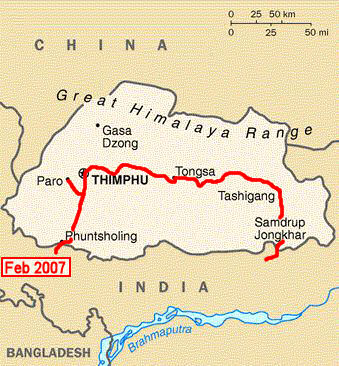
Distance 978 km (487667 km to 488645 km)
This is part of the thirteenth section of our
around the world trip.
Complete Trip Overview &
Map
Coming from India
17/2/07 (For background information on visiting Bhutan go back to India)
We moved through the entrance gateway, where we had been
refused entry yesterday, but this time on the motorcycle, papers were
not asked for, and we rode into the Bhutan duty free zone. Remaining in
a comfortable, actually exceptionally comfortable hotel, compared to
our
usual standard, within the duty free zone, we hope our motorcycle's
paperwork
will be cleared tomorrow morning without problems. A pleasant evening
dinner
meeting the other tour(ists) who are mostly Australians, a New
Zealander
or two and a Dutch woman.
18/2/07 An indication of people's satisfaction with a trip is
the rate of return of past customers. This trip has almost half of its
members having been on one of Mike's (Ferris Wheels Motorcycle Tours)
previous trips.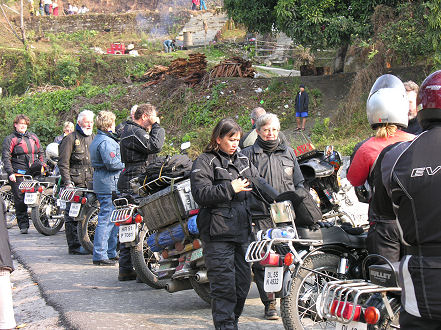 Enfields are not easy
motorcycles to ride. The gear lever is on the
left and rear brake on the right, opposite from all modern motorcycles.
Gears are one up and three down, again opposite. Any regular
motorcyclist,
apart from learning to ride in this hectic part of the world, has to
also adjust to this reversal of their usual riding style. Their first
day out was is dense fog on a road that still had patches of snow,
quite
an introduction. The other punters are now used to their motorcycles
and this morning the staff has them lined up, warmed up and minor
adjustments made by the time we had to leave. The duty free zone
finishes five km's
out of town and as promised, our motorcycle paperwork problem had been
overcome. We are taking a back seat to paperwork for the next ten days
so we didn't even ask how. With our passports stamped into Bhutan we
entered
the country, proper. Initially there is little difference to other
mountain
regions in the area, some Bhuddist shrines, monks and some basic
dwellings.
The road climbed with filtered cloudy views back down the valley over
Phuntsholing. The traffic was light and incredibly polite. They have a
great rule here, if a following vehicle
Enfields are not easy
motorcycles to ride. The gear lever is on the
left and rear brake on the right, opposite from all modern motorcycles.
Gears are one up and three down, again opposite. Any regular
motorcyclist,
apart from learning to ride in this hectic part of the world, has to
also adjust to this reversal of their usual riding style. Their first
day out was is dense fog on a road that still had patches of snow,
quite
an introduction. The other punters are now used to their motorcycles
and this morning the staff has them lined up, warmed up and minor
adjustments made by the time we had to leave. The duty free zone
finishes five km's
out of town and as promised, our motorcycle paperwork problem had been
overcome. We are taking a back seat to paperwork for the next ten days
so we didn't even ask how. With our passports stamped into Bhutan we
entered
the country, proper. Initially there is little difference to other
mountain
regions in the area, some Bhuddist shrines, monks and some basic
dwellings.
The road climbed with filtered cloudy views back down the valley over
Phuntsholing. The traffic was light and incredibly polite. They have a
great rule here, if a following vehicle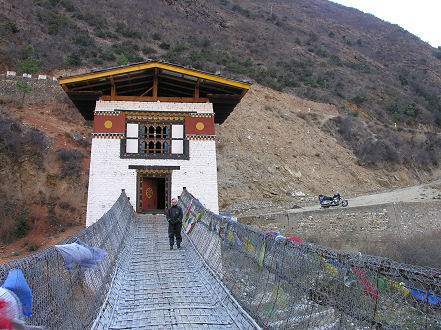 toots their horn, the
lead vehicle "must" pull over to let them pass, and they actually do
it, making the winding, hilly mountain roads easy to ride. Morning tea
at a small roadside village and a fantastic lunch overlooking a
hydroelectric dam. Before lunch the road meandered through dense cloud
forests. Some landslides, unrepaired gravel sections, still wet, kept
the group moving cautiously as did patches of thick fog. By afternoon
the skies had cleared, the road dried and the snow capped mountains and
steep sided gorges became visible along with many waterfalls. Mike and
Denise allow their groups a large degree of freedom in riding.
Encouraged to stop for
photos, to look at sights along the way and to avoid riding as a group
they
let us free ride after lunch, with the backup bus a sweep in case of
breakdown
or incident. We stopped at a water driven prayer wheel, a small Hindu
temple, an ancient Dzong, with a suspension bridge access across a
river. We also stopped to help a local motorcyclist who had run off the
road. After assisting him back on the road we realised he was drunk. He
rode away only to have another accident in the next town, lying on the
road, seemingly unhurt,
surrounded by locals. Today is Bhutan's new year and people
toots their horn, the
lead vehicle "must" pull over to let them pass, and they actually do
it, making the winding, hilly mountain roads easy to ride. Morning tea
at a small roadside village and a fantastic lunch overlooking a
hydroelectric dam. Before lunch the road meandered through dense cloud
forests. Some landslides, unrepaired gravel sections, still wet, kept
the group moving cautiously as did patches of thick fog. By afternoon
the skies had cleared, the road dried and the snow capped mountains and
steep sided gorges became visible along with many waterfalls. Mike and
Denise allow their groups a large degree of freedom in riding.
Encouraged to stop for
photos, to look at sights along the way and to avoid riding as a group
they
let us free ride after lunch, with the backup bus a sweep in case of
breakdown
or incident. We stopped at a water driven prayer wheel, a small Hindu
temple, an ancient Dzong, with a suspension bridge access across a
river. We also stopped to help a local motorcyclist who had run off the
road. After assisting him back on the road we realised he was drunk. He
rode away only to have another accident in the next town, lying on the
road, seemingly unhurt,
surrounded by locals. Today is Bhutan's new year and people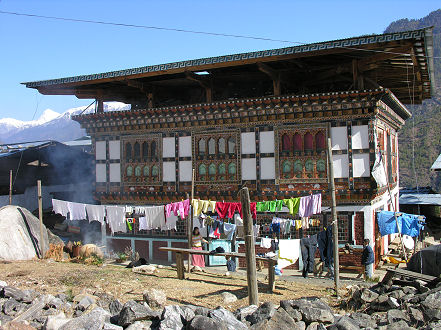 were out
in the fields playing traditional sports, like dart throwing, over 20
metres, heavy darts thrown at a small target and archery.
were out
in the fields playing traditional sports, like dart throwing, over 20
metres, heavy darts thrown at a small target and archery.
19/2/07 Until a few years ago Bhutan used to limit it's tourist
numbers to 10,000 a year, or just 27 tourists crossing the border each
day. As the infrastructure has improved there is currently no upper
limit to numbers but the increase in tourism, whilst steady is still
slow, 17,000 this year and 20,000 expected next year. This low tourist
numbers has helped to
keep the population interested and excited at seeing foreigners. As we
pass through the country people wave, smile and are genuinely
interested in the motorcycle tour. Today we left the motorcycles behind
and took to
the support bus, which has been carrying everyone else's luggage. A
viewpoint of the surrounding mountains covered in snow followed with a
casual visit to some local archers. Bhutan's New Year lasts for a few
days, another holiday today, people are still out playing but today's
main event for us was
to climb a mountain to Tiger's Nest. Originally a cave, believed to
have
been inhabited by a reincarnation of Buddha for three months in the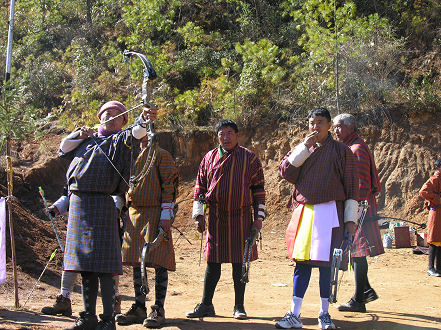 seventh century, it
is now Bhutan's most important religious site. The only access is via a
steep walk, two hours, 500m of vertical climb through pine and sphagnum
moss forests. The reward is stunning. Perched on a cliff, fortress
like, an access that is easily defended. The building has been recently
restored after a fire and four large incarnations of Buddha
await the energetic inside a locked room. The original cave where
Buddha
is said to have flown in on the back of a tiger can also be visited.
About
half of our group made it to the nest, some stopped half way at a
restaurant
and a few decided to have a total rest day back in town. I had been
walking
slowly uphill with Kay and we were a bit behind the group intending to
walk
to the top when we stopped at the rest house. Here a lady with five
pack
horses was descending. Quick negotiations had me on the back of one of
the
horses, the lady leading, we quickly ascended the remaining distance to
the
dzong. We were later rewarded by our guide singing love and romantic
songs
as we descended back down the mountainside to the awaiting bus.
seventh century, it
is now Bhutan's most important religious site. The only access is via a
steep walk, two hours, 500m of vertical climb through pine and sphagnum
moss forests. The reward is stunning. Perched on a cliff, fortress
like, an access that is easily defended. The building has been recently
restored after a fire and four large incarnations of Buddha
await the energetic inside a locked room. The original cave where
Buddha
is said to have flown in on the back of a tiger can also be visited.
About
half of our group made it to the nest, some stopped half way at a
restaurant
and a few decided to have a total rest day back in town. I had been
walking
slowly uphill with Kay and we were a bit behind the group intending to
walk
to the top when we stopped at the rest house. Here a lady with five
pack
horses was descending. Quick negotiations had me on the back of one of
the
horses, the lady leading, we quickly ascended the remaining distance to
the
dzong. We were later rewarded by our guide singing love and romantic
songs
as we descended back down the mountainside to the awaiting bus.
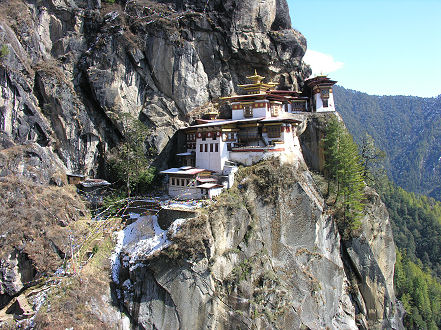 20/2/07 It is a difficult
balancing act that Bhutan has undertaken to trying to keep its culture
yet allowing itself modern trimmings. Basically a Bhuddist country,
monks can sometimes be seen removing a mobile phone from their cloak
for a chat. About a third of the men we have seen wear the traditional
Gho, a cloak to the knees and long stockings. School uniform is also
traditional. Most of the buildings, new and old, are of a similar basic
design, wooden windows, large timber beams, painted intricately.
The traditional wooden slab roofs held down with rocks has almost
entirely
been replaced with metal rooves. Internet cafe's are prevalent in
Thimpu,
the capital, and many large SUV motor vehicles drive the streets. We
visited
the National Museum in Paro before a short ride to Thimpu. The planned
ride
through the mountains to Ha had to be cancelled due to snow and ice,
from
last week's falls, blocking the road. Major roadworks are currently
being
undertaken and temporary road closures slowed our progress. Whilst
waiting
at one of these roadblocks two riders from
India,
on local motorcycles, overloaded with
20/2/07 It is a difficult
balancing act that Bhutan has undertaken to trying to keep its culture
yet allowing itself modern trimmings. Basically a Bhuddist country,
monks can sometimes be seen removing a mobile phone from their cloak
for a chat. About a third of the men we have seen wear the traditional
Gho, a cloak to the knees and long stockings. School uniform is also
traditional. Most of the buildings, new and old, are of a similar basic
design, wooden windows, large timber beams, painted intricately.
The traditional wooden slab roofs held down with rocks has almost
entirely
been replaced with metal rooves. Internet cafe's are prevalent in
Thimpu,
the capital, and many large SUV motor vehicles drive the streets. We
visited
the National Museum in Paro before a short ride to Thimpu. The planned
ride
through the mountains to Ha had to be cancelled due to snow and ice,
from
last week's falls, blocking the road. Major roadworks are currently
being
undertaken and temporary road closures slowed our progress. Whilst
waiting
at one of these roadblocks two riders from
India,
on local motorcycles, overloaded with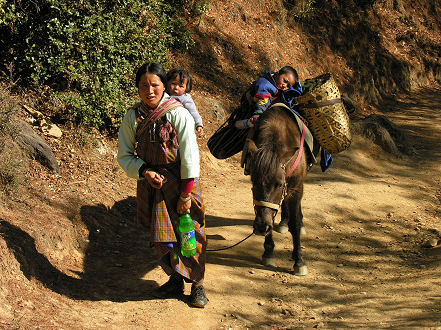 gear for their long journey through to West India, hopefully Myanmar
(Burma) and Bangladesh rode up. Srinidhi and Kishore, from Bangalore,
had already been on the road for over two months and were moving more
quickly through the scenery than us.
gear for their long journey through to West India, hopefully Myanmar
(Burma) and Bangladesh rode up. Srinidhi and Kishore, from Bangalore,
had already been on the road for over two months and were moving more
quickly through the scenery than us.
21/2/07 Bhutan has a close relationship with India. India builds all of
Bhutan's border roads and Bhutan supplying hydroelectricity to India.
Almost all of Bhutan's goods come across the land border at
Phuntsholing. Some other goods arrive from China, the country's other
neighbour, on mules and horses. We had an optional free day but most
people took the half day tour of local attractions. A stupa to the
memorial of the third king, Changangkha Monastery, viewpoint hill top
with its prayer flags wavering in the wind, and the Takin reserve. The
Takin, Bhutan's national animal, is believed in folklore to be a cross
between a cow and a goat, and that is what it looks
like. It normally lives in the high mountains. Our local guide, Sonam,
his
wife and one month old daughter live in Thimpu. The seventeen members
of
our tour were invited to their home for lunch. There were four, locally
made,
alcoholic drinks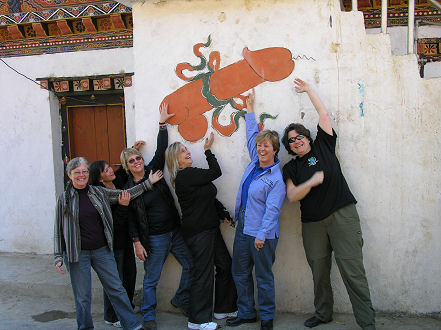 to get
lunch underway. The first was a fermented rice wine. Soft, crushed
grains of rice were still in the mix making it more a soup rather than
a drink, served warm. The second, also warm, was a mix of eggs, butter
and
rice. Neither of those two were westernly highly palatable but our
third
drink, made from wheat and yeast, soaked for over a month to ferment,
was
well received and had some people requesting refills. The fourth, made
from
corn, was a little like moonshine. Lunch was equal in variety to the
drinks,
with chinese mushrooms, dried meats and glass noodles, local spinach
and
rice. It was a great opportunity to see inside one of the local homes
we
have been passing since arriving in the country. By early afternoon
most
of us chose to relax the rest of the day away at our hotel.
to get
lunch underway. The first was a fermented rice wine. Soft, crushed
grains of rice were still in the mix making it more a soup rather than
a drink, served warm. The second, also warm, was a mix of eggs, butter
and
rice. Neither of those two were westernly highly palatable but our
third
drink, made from wheat and yeast, soaked for over a month to ferment,
was
well received and had some people requesting refills. The fourth, made
from
corn, was a little like moonshine. Lunch was equal in variety to the
drinks,
with chinese mushrooms, dried meats and glass noodles, local spinach
and
rice. It was a great opportunity to see inside one of the local homes
we
have been passing since arriving in the country. By early afternoon
most
of us chose to relax the rest of the day away at our hotel.
22/2/07 There is a building boom occurring in Bhutan's cities.
Using nothing more than bamboo for scaffolding, five storied buildings
are
popping up. In some areas the place looks like a construction zone
where
many new buildings are being built. We left behind Thimpu as we climbed
up to a 3200m pass with snow still deep alongside the road. The air
remained
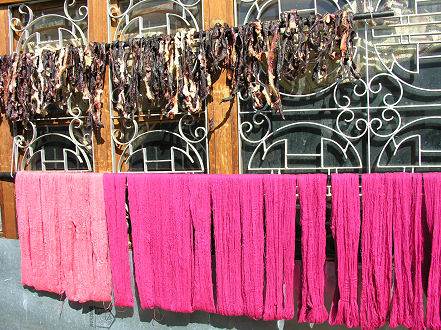 clear and with sunshine we had
great views across to heavily snow covered peaks in the distance. The
500cc Enfields move along quickly, their rider's luggage carried in the
backup bus. Some riders chose the next destination to quickly head for,
whilst others stopped to admire the scenery and for photos along the
way. Punakha Dzong was built in the 17th Century and is still a centre
for government in the region. The Dzongs were originally
built for the defence of the surrounding lands, now some are used for
government or religious purposes. Photographs are not permitted inside
the buildings which have been magnificently painted and recently
restored. In the afternoon we chose to let the group go ahead and have
a bit of riding time to ourselves. Despite the many check posts each
day, we are rarely stopped, our guide, usually following, handles the
paperwork often after the group has long
gone. We let the backup vehicle go ahead with the other motorcycle's
luggage
and stopped in Wangdi for a beer in a local bar. Wangdi is a small
roadside
town of old wood and mud shops where life probably hasn't changed for
centuries and yet our hotel, just 10km away, situated by
clear and with sunshine we had
great views across to heavily snow covered peaks in the distance. The
500cc Enfields move along quickly, their rider's luggage carried in the
backup bus. Some riders chose the next destination to quickly head for,
whilst others stopped to admire the scenery and for photos along the
way. Punakha Dzong was built in the 17th Century and is still a centre
for government in the region. The Dzongs were originally
built for the defence of the surrounding lands, now some are used for
government or religious purposes. Photographs are not permitted inside
the buildings which have been magnificently painted and recently
restored. In the afternoon we chose to let the group go ahead and have
a bit of riding time to ourselves. Despite the many check posts each
day, we are rarely stopped, our guide, usually following, handles the
paperwork often after the group has long
gone. We let the backup vehicle go ahead with the other motorcycle's
luggage
and stopped in Wangdi for a beer in a local bar. Wangdi is a small
roadside
town of old wood and mud shops where life probably hasn't changed for
centuries and yet our hotel, just 10km away, situated by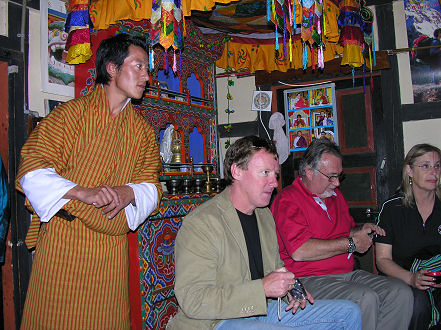 a roaring stream in a
lovely garden, is as modern and well appointed as any western
destination.
a roaring stream in a
lovely garden, is as modern and well appointed as any western
destination.
23/2/07 Cigarette smoking is banned in public places within the
Kingdom and heavily discouraged however the chewing of beetle nut
occurs openly. The streets are often dotted with the red spittle,
discharged after it has been chewed. A mild narcotic, it is also
popular in India, leaving behind red decaying teeth in prolonged users.
An earlier start for the
190km day with two mountain passes over 3400m. Other traffic has all
but
disappeared. The bumpy asphalt road just wide enough for a car and
motorcycle
to pass comfortably as it continuously twists, switch backing on itself
up and down through a valley or winding around the side of a mountain.
Cut
mostly by hand, and using the debris from landslides, women, with young
children
at their sides, break up stones, whilst men concrete the roadside
gutters,
mixing the cement by hand. Snow had only recently cleared from the road
surface and was still alongside making it a picture to travel through.
At
the higher passes yak were grazing on the bamboo grasses. The Dzong at
Tongsa
is half way across the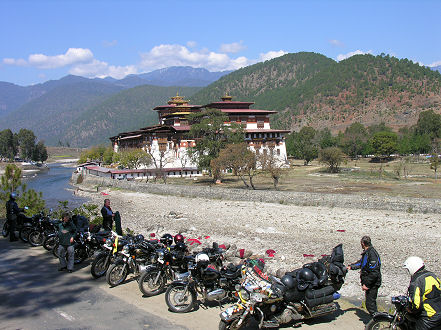 country
and used to be the main seat of government for the first king. Even
today future kings have to spend time here as governor before they can
become the king of Bhutan. Like most other Dzong we have visited it is
situated in a great defensive position on a ridge or with a river
protecting it on
one side. The further east we travel the fewer tourists are in the
area.
After lunch we didn't see any and whilst travelling at this time of
year
it is colder the relative lack of any other tourists means we are
getting the best hotels available. Our accommodation tonight is more
basic, a worker's cottage style, connected units facing onto a verandah
with a home-made metal firebox wood heater for warmth, adding to the
atmosphere. We had used the whole day, arriving just as the sun was
setting. A little cold, the large wood heater and hot tea was
welcoming.
country
and used to be the main seat of government for the first king. Even
today future kings have to spend time here as governor before they can
become the king of Bhutan. Like most other Dzong we have visited it is
situated in a great defensive position on a ridge or with a river
protecting it on
one side. The further east we travel the fewer tourists are in the
area.
After lunch we didn't see any and whilst travelling at this time of
year
it is colder the relative lack of any other tourists means we are
getting the best hotels available. Our accommodation tonight is more
basic, a worker's cottage style, connected units facing onto a verandah
with a home-made metal firebox wood heater for warmth, adding to the
atmosphere. We had used the whole day, arriving just as the sun was
setting. A little cold, the large wood heater and hot tea was
welcoming.
24/2/07 The tour has settled into a routine. Breakfast at about
8am, departure for the first event, riding or sightseeing at 9am,
evening
drinks at the bar 6.30, and a slow walk to dinner near 8pm. The last
of the "rest days"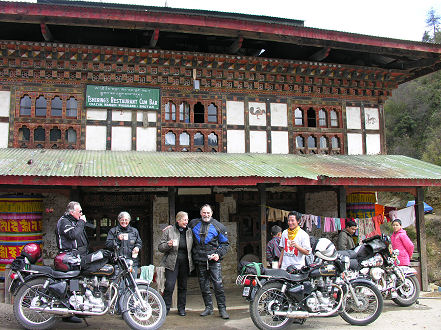 for the tour we visited a local
dairy and followed the process through to butter and cheese making, all
done by hand. Our group bought a selection of locally made apple and
pear alcohol, cider, jams and apple juice for the planned yak (high
altitude cow) barbecue cooked by group members. We visited two
monasteries, Jampa, built in the 7th century and Kurjey from the 8th
century, still functioning today. The rest of the day was actually a
rest, with us doing some regular maintenance on the motorcycle and most
of the others catching up on diary and postcard writings, the higher
altitude keeping everyone a little tired. The planned evening yak BBQ
couldn't eventuate as meat for the next month can not be slaughtered.
Bhutan has three such
periods in the year where no animals can be killed. They also have
alcohol
free days in some hotels.
for the tour we visited a local
dairy and followed the process through to butter and cheese making, all
done by hand. Our group bought a selection of locally made apple and
pear alcohol, cider, jams and apple juice for the planned yak (high
altitude cow) barbecue cooked by group members. We visited two
monasteries, Jampa, built in the 7th century and Kurjey from the 8th
century, still functioning today. The rest of the day was actually a
rest, with us doing some regular maintenance on the motorcycle and most
of the others catching up on diary and postcard writings, the higher
altitude keeping everyone a little tired. The planned evening yak BBQ
couldn't eventuate as meat for the next month can not be slaughtered.
Bhutan has three such
periods in the year where no animals can be killed. They also have
alcohol
free days in some hotels.
25/2/07 The only problem we can see with the tour so far is
that
we are liking it too much and won't be looking forward to returning to
our
more usual level of accommodation and meals. Whilst we miss a bit of
"traveller"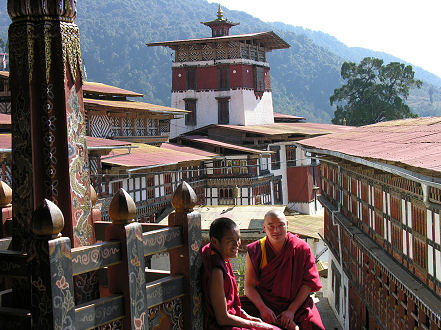 conversation and eating in roadside or small city restaurants, we
certainly are enjoying the daytime freedom of movement that Mike and
Denise's tours offer, (Ferris Wheels Motorcycle Tours),
with the certainty of a hotel at the end of the day and great
conversation with the tour group reliving the day's events in the
evenings over a drink. Today's ride was the most adventurous so far and
best scenery. A flexible departure time had riders leaving between
8-9am. The earlier ones hitting snow and some ice on the road about an
hour into the ride. Not yet chopped up by the few passing trucks or
cars,
it was slow riding. Leading up to the 3800m pass, the trip's highest,
the
road disintegrated into spongy mud with 30cm of snow lining each side.
Traction
was good but the softness of the underlying ground made riding
difficult.
The downhill side had been machine cleared and was good asphalt. Years
ago
the road had been hand cut into the almost vertical cliffs, 300 plus
people
died in it's construction, winding down through spruce and conifer
forests,
to rhododendrons, some flowering but most just budding, past waterfalls
and
into temperate rainforest vegetation before arriving at a dryland
mountain
valley. It was another
conversation and eating in roadside or small city restaurants, we
certainly are enjoying the daytime freedom of movement that Mike and
Denise's tours offer, (Ferris Wheels Motorcycle Tours),
with the certainty of a hotel at the end of the day and great
conversation with the tour group reliving the day's events in the
evenings over a drink. Today's ride was the most adventurous so far and
best scenery. A flexible departure time had riders leaving between
8-9am. The earlier ones hitting snow and some ice on the road about an
hour into the ride. Not yet chopped up by the few passing trucks or
cars,
it was slow riding. Leading up to the 3800m pass, the trip's highest,
the
road disintegrated into spongy mud with 30cm of snow lining each side.
Traction
was good but the softness of the underlying ground made riding
difficult.
The downhill side had been machine cleared and was good asphalt. Years
ago
the road had been hand cut into the almost vertical cliffs, 300 plus
people
died in it's construction, winding down through spruce and conifer
forests,
to rhododendrons, some flowering but most just budding, past waterfalls
and
into temperate rainforest vegetation before arriving at a dryland
mountain
valley. It was another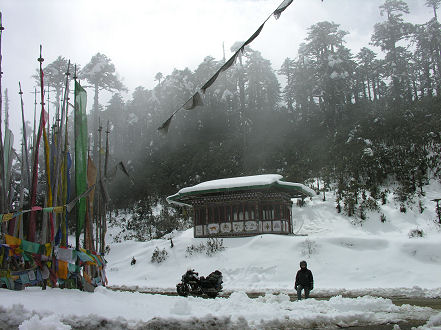 climb
for the motorcycles to Mongar, a small town for the night, 20km up from
the valley floor yet we could still see the river crossing bridge
directly below us.
climb
for the motorcycles to Mongar, a small town for the night, 20km up from
the valley floor yet we could still see the river crossing bridge
directly below us.
26/2/07 Thunderstorms passed through in early morning and as we
left our hotel we were pleased to have crossed the high pass yesterday
as fresh snow was in the tree tops on nearby hills and local reports
that the road behind had been closed due to snow. Just 90km to the town
of Trashigang, Bhutan's second largest, but with only a couple of small
hotels had a remote country town feel. Our hotel overlooks the local
Dzong, currently being
renovated. The road, pretty much the same in this part of Bhutan,
winding
up and down over mountains and crossing rivers, almost traffic free,
with
magnificent views. One 2500m pass with red rhododendrons just starting
to flower dotted the hills. Kay and I rode down to the local dzong on
our
own to a warm welcoming and were guided around by a young monk. A
monastery
that receives few tourists, and just on our own, we were taken into the
monk's private quarters. He shares a room, one bed, for his teacher, he
and three other 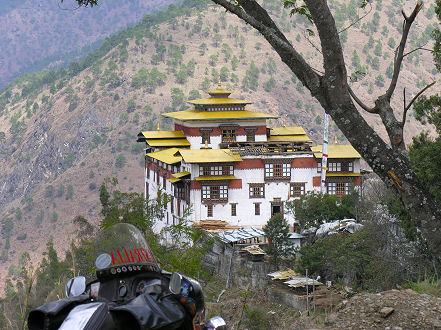 novices sleep on the
floor. A prayer service was underway and again we were invited to watch
and take photos, something we have been unable to do in other
monasteries. Monks were playing the long and short trumpets, a drum,
cymbals, and were chanting whilst other monks individually came,
prayed, lit candles and left. The monastery is getting a new roof and
repainting of the faded canvasses that drape many of the walls. It is
the first unrenovated monastery we have visited and had an older,
warmer feel to the place. 2008 is the year of Bhutan and there is much
activity renovating and building in preparation.
novices sleep on the
floor. A prayer service was underway and again we were invited to watch
and take photos, something we have been unable to do in other
monasteries. Monks were playing the long and short trumpets, a drum,
cymbals, and were chanting whilst other monks individually came,
prayed, lit candles and left. The monastery is getting a new roof and
repainting of the faded canvasses that drape many of the walls. It is
the first unrenovated monastery we have visited and had an older,
warmer feel to the place. 2008 is the year of Bhutan and there is much
activity renovating and building in preparation.
27/2/07 All of our paperwork has been completed by our Bhutan
guide. We have not had to arrange any of the many permits necessary to
visit the different dzong or monasteries, extra permits to visit their
inner sanctions, or paperwork to be travelling in this part of the
country to pass the many roadblocks. Hotel registrations are also done
by the guide. This service has been excellent, as has the patience of
the police at road blocks,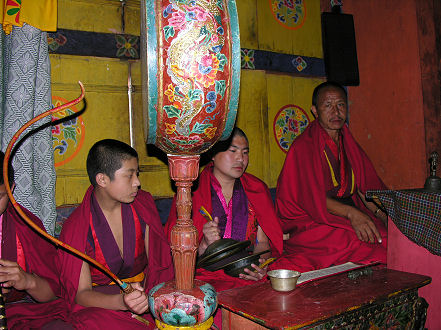 who almost always let us pass if
we are ahead of the guide's vehicle, which is often leapfrogging
between the motorcycles, often spread out over a couple of hours. Our
last day's riding in Bhutan we all left at 8.00
am for the 180km to the border town of Samdrup Jongkhar but were soon
strung out along the road with the destination riders moving quickly
and the remainder, not wanting to leave the solitude of the mountains,
dragging their heels. Possibly the coldest day as it had again rained
overnight and left fog
blanketing the sun. Dampness entered the riders and the road remained
wet
for most of the day. This didn't affect the group's mood as stunning
scenery
and dense rainforest vegetation rolled through as we travelled. The
road
surface deteriorated, now maintained by the Indian border authorities
as
opposed to the local authority's roads we have been riding on for the
last
week.
who almost always let us pass if
we are ahead of the guide's vehicle, which is often leapfrogging
between the motorcycles, often spread out over a couple of hours. Our
last day's riding in Bhutan we all left at 8.00
am for the 180km to the border town of Samdrup Jongkhar but were soon
strung out along the road with the destination riders moving quickly
and the remainder, not wanting to leave the solitude of the mountains,
dragging their heels. Possibly the coldest day as it had again rained
overnight and left fog
blanketing the sun. Dampness entered the riders and the road remained
wet
for most of the day. This didn't affect the group's mood as stunning
scenery
and dense rainforest vegetation rolled through as we travelled. The
road
surface deteriorated, now maintained by the Indian border authorities
as
opposed to the local authority's roads we have been riding on for the
last
week.
28/2/07 Samdrup Jongkhar is a typical border town and not
really indicative of Bhutan. It is a transition, a half way house,
getting us prepared once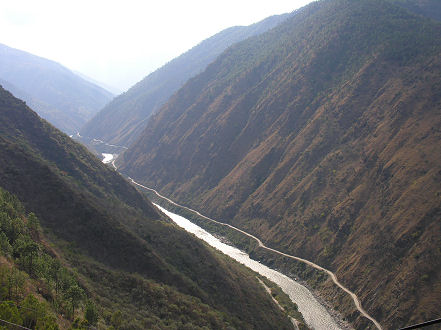 again to enter India's barrage of the senses.
Our paperwork had been checked out of Bhutan yesterday evening,
avoiding another day's high tourist charge, and this morning, with a
change of escort vehicles we crossed
into India.
again to enter India's barrage of the senses.
Our paperwork had been checked out of Bhutan yesterday evening,
avoiding another day's high tourist charge, and this morning, with a
change of escort vehicles we crossed
into India.
Move with us to India
 Enfields are not easy
motorcycles to ride. The gear lever is on the
left and rear brake on the right, opposite from all modern motorcycles.
Gears are one up and three down, again opposite. Any regular
motorcyclist,
apart from learning to ride in this hectic part of the world, has to
also adjust to this reversal of their usual riding style. Their first
day out was is dense fog on a road that still had patches of snow,
quite
an introduction. The other punters are now used to their motorcycles
and this morning the staff has them lined up, warmed up and minor
adjustments made by the time we had to leave. The duty free zone
finishes five km's
out of town and as promised, our motorcycle paperwork problem had been
overcome. We are taking a back seat to paperwork for the next ten days
so we didn't even ask how. With our passports stamped into Bhutan we
entered
the country, proper. Initially there is little difference to other
mountain
regions in the area, some Bhuddist shrines, monks and some basic
dwellings.
The road climbed with filtered cloudy views back down the valley over
Phuntsholing. The traffic was light and incredibly polite. They have a
great rule here, if a following vehicle
Enfields are not easy
motorcycles to ride. The gear lever is on the
left and rear brake on the right, opposite from all modern motorcycles.
Gears are one up and three down, again opposite. Any regular
motorcyclist,
apart from learning to ride in this hectic part of the world, has to
also adjust to this reversal of their usual riding style. Their first
day out was is dense fog on a road that still had patches of snow,
quite
an introduction. The other punters are now used to their motorcycles
and this morning the staff has them lined up, warmed up and minor
adjustments made by the time we had to leave. The duty free zone
finishes five km's
out of town and as promised, our motorcycle paperwork problem had been
overcome. We are taking a back seat to paperwork for the next ten days
so we didn't even ask how. With our passports stamped into Bhutan we
entered
the country, proper. Initially there is little difference to other
mountain
regions in the area, some Bhuddist shrines, monks and some basic
dwellings.
The road climbed with filtered cloudy views back down the valley over
Phuntsholing. The traffic was light and incredibly polite. They have a
great rule here, if a following vehicle toots their horn, the
lead vehicle "must" pull over to let them pass, and they actually do
it, making the winding, hilly mountain roads easy to ride. Morning tea
at a small roadside village and a fantastic lunch overlooking a
hydroelectric dam. Before lunch the road meandered through dense cloud
forests. Some landslides, unrepaired gravel sections, still wet, kept
the group moving cautiously as did patches of thick fog. By afternoon
the skies had cleared, the road dried and the snow capped mountains and
steep sided gorges became visible along with many waterfalls. Mike and
Denise allow their groups a large degree of freedom in riding.
Encouraged to stop for
photos, to look at sights along the way and to avoid riding as a group
they
let us free ride after lunch, with the backup bus a sweep in case of
breakdown
or incident. We stopped at a water driven prayer wheel, a small Hindu
temple, an ancient Dzong, with a suspension bridge access across a
river. We also stopped to help a local motorcyclist who had run off the
road. After assisting him back on the road we realised he was drunk. He
rode away only to have another accident in the next town, lying on the
road, seemingly unhurt,
surrounded by locals. Today is Bhutan's new year and people
toots their horn, the
lead vehicle "must" pull over to let them pass, and they actually do
it, making the winding, hilly mountain roads easy to ride. Morning tea
at a small roadside village and a fantastic lunch overlooking a
hydroelectric dam. Before lunch the road meandered through dense cloud
forests. Some landslides, unrepaired gravel sections, still wet, kept
the group moving cautiously as did patches of thick fog. By afternoon
the skies had cleared, the road dried and the snow capped mountains and
steep sided gorges became visible along with many waterfalls. Mike and
Denise allow their groups a large degree of freedom in riding.
Encouraged to stop for
photos, to look at sights along the way and to avoid riding as a group
they
let us free ride after lunch, with the backup bus a sweep in case of
breakdown
or incident. We stopped at a water driven prayer wheel, a small Hindu
temple, an ancient Dzong, with a suspension bridge access across a
river. We also stopped to help a local motorcyclist who had run off the
road. After assisting him back on the road we realised he was drunk. He
rode away only to have another accident in the next town, lying on the
road, seemingly unhurt,
surrounded by locals. Today is Bhutan's new year and people were out
in the fields playing traditional sports, like dart throwing, over 20
metres, heavy darts thrown at a small target and archery.
were out
in the fields playing traditional sports, like dart throwing, over 20
metres, heavy darts thrown at a small target and archery.
 seventh century, it
is now Bhutan's most important religious site. The only access is via a
steep walk, two hours, 500m of vertical climb through pine and sphagnum
moss forests. The reward is stunning. Perched on a cliff, fortress
like, an access that is easily defended. The building has been recently
restored after a fire and four large incarnations of Buddha
await the energetic inside a locked room. The original cave where
Buddha
is said to have flown in on the back of a tiger can also be visited.
About
half of our group made it to the nest, some stopped half way at a
restaurant
and a few decided to have a total rest day back in town. I had been
walking
slowly uphill with Kay and we were a bit behind the group intending to
walk
to the top when we stopped at the rest house. Here a lady with five
pack
horses was descending. Quick negotiations had me on the back of one of
the
horses, the lady leading, we quickly ascended the remaining distance to
the
dzong. We were later rewarded by our guide singing love and romantic
songs
as we descended back down the mountainside to the awaiting bus.
seventh century, it
is now Bhutan's most important religious site. The only access is via a
steep walk, two hours, 500m of vertical climb through pine and sphagnum
moss forests. The reward is stunning. Perched on a cliff, fortress
like, an access that is easily defended. The building has been recently
restored after a fire and four large incarnations of Buddha
await the energetic inside a locked room. The original cave where
Buddha
is said to have flown in on the back of a tiger can also be visited.
About
half of our group made it to the nest, some stopped half way at a
restaurant
and a few decided to have a total rest day back in town. I had been
walking
slowly uphill with Kay and we were a bit behind the group intending to
walk
to the top when we stopped at the rest house. Here a lady with five
pack
horses was descending. Quick negotiations had me on the back of one of
the
horses, the lady leading, we quickly ascended the remaining distance to
the
dzong. We were later rewarded by our guide singing love and romantic
songs
as we descended back down the mountainside to the awaiting bus.
 20/2/07 It is a difficult
balancing act that Bhutan has undertaken to trying to keep its culture
yet allowing itself modern trimmings. Basically a Bhuddist country,
monks can sometimes be seen removing a mobile phone from their cloak
for a chat. About a third of the men we have seen wear the traditional
Gho, a cloak to the knees and long stockings. School uniform is also
traditional. Most of the buildings, new and old, are of a similar basic
design, wooden windows, large timber beams, painted intricately.
The traditional wooden slab roofs held down with rocks has almost
entirely
been replaced with metal rooves. Internet cafe's are prevalent in
Thimpu,
the capital, and many large SUV motor vehicles drive the streets. We
visited
the National Museum in Paro before a short ride to Thimpu. The planned
ride
through the mountains to Ha had to be cancelled due to snow and ice,
from
last week's falls, blocking the road. Major roadworks are currently
being
undertaken and temporary road closures slowed our progress. Whilst
waiting
at one of these roadblocks two riders from
India,
on local motorcycles, overloaded with
20/2/07 It is a difficult
balancing act that Bhutan has undertaken to trying to keep its culture
yet allowing itself modern trimmings. Basically a Bhuddist country,
monks can sometimes be seen removing a mobile phone from their cloak
for a chat. About a third of the men we have seen wear the traditional
Gho, a cloak to the knees and long stockings. School uniform is also
traditional. Most of the buildings, new and old, are of a similar basic
design, wooden windows, large timber beams, painted intricately.
The traditional wooden slab roofs held down with rocks has almost
entirely
been replaced with metal rooves. Internet cafe's are prevalent in
Thimpu,
the capital, and many large SUV motor vehicles drive the streets. We
visited
the National Museum in Paro before a short ride to Thimpu. The planned
ride
through the mountains to Ha had to be cancelled due to snow and ice,
from
last week's falls, blocking the road. Major roadworks are currently
being
undertaken and temporary road closures slowed our progress. Whilst
waiting
at one of these roadblocks two riders from
India,
on local motorcycles, overloaded with gear for their long journey through to West India, hopefully Myanmar
(Burma) and Bangladesh rode up. Srinidhi and Kishore, from Bangalore,
had already been on the road for over two months and were moving more
quickly through the scenery than us.
gear for their long journey through to West India, hopefully Myanmar
(Burma) and Bangladesh rode up. Srinidhi and Kishore, from Bangalore,
had already been on the road for over two months and were moving more
quickly through the scenery than us.  to get
lunch underway. The first was a fermented rice wine. Soft, crushed
grains of rice were still in the mix making it more a soup rather than
a drink, served warm. The second, also warm, was a mix of eggs, butter
and
rice. Neither of those two were westernly highly palatable but our
third
drink, made from wheat and yeast, soaked for over a month to ferment,
was
well received and had some people requesting refills. The fourth, made
from
corn, was a little like moonshine. Lunch was equal in variety to the
drinks,
with chinese mushrooms, dried meats and glass noodles, local spinach
and
rice. It was a great opportunity to see inside one of the local homes
we
have been passing since arriving in the country. By early afternoon
most
of us chose to relax the rest of the day away at our hotel.
to get
lunch underway. The first was a fermented rice wine. Soft, crushed
grains of rice were still in the mix making it more a soup rather than
a drink, served warm. The second, also warm, was a mix of eggs, butter
and
rice. Neither of those two were westernly highly palatable but our
third
drink, made from wheat and yeast, soaked for over a month to ferment,
was
well received and had some people requesting refills. The fourth, made
from
corn, was a little like moonshine. Lunch was equal in variety to the
drinks,
with chinese mushrooms, dried meats and glass noodles, local spinach
and
rice. It was a great opportunity to see inside one of the local homes
we
have been passing since arriving in the country. By early afternoon
most
of us chose to relax the rest of the day away at our hotel. clear and with sunshine we had
great views across to heavily snow covered peaks in the distance. The
500cc Enfields move along quickly, their rider's luggage carried in the
backup bus. Some riders chose the next destination to quickly head for,
whilst others stopped to admire the scenery and for photos along the
way. Punakha Dzong was built in the 17th Century and is still a centre
for government in the region. The Dzongs were originally
built for the defence of the surrounding lands, now some are used for
government or religious purposes. Photographs are not permitted inside
the buildings which have been magnificently painted and recently
restored. In the afternoon we chose to let the group go ahead and have
a bit of riding time to ourselves. Despite the many check posts each
day, we are rarely stopped, our guide, usually following, handles the
paperwork often after the group has long
gone. We let the backup vehicle go ahead with the other motorcycle's
luggage
and stopped in Wangdi for a beer in a local bar. Wangdi is a small
roadside
town of old wood and mud shops where life probably hasn't changed for
centuries and yet our hotel, just 10km away, situated by
clear and with sunshine we had
great views across to heavily snow covered peaks in the distance. The
500cc Enfields move along quickly, their rider's luggage carried in the
backup bus. Some riders chose the next destination to quickly head for,
whilst others stopped to admire the scenery and for photos along the
way. Punakha Dzong was built in the 17th Century and is still a centre
for government in the region. The Dzongs were originally
built for the defence of the surrounding lands, now some are used for
government or religious purposes. Photographs are not permitted inside
the buildings which have been magnificently painted and recently
restored. In the afternoon we chose to let the group go ahead and have
a bit of riding time to ourselves. Despite the many check posts each
day, we are rarely stopped, our guide, usually following, handles the
paperwork often after the group has long
gone. We let the backup vehicle go ahead with the other motorcycle's
luggage
and stopped in Wangdi for a beer in a local bar. Wangdi is a small
roadside
town of old wood and mud shops where life probably hasn't changed for
centuries and yet our hotel, just 10km away, situated by a roaring stream in a
lovely garden, is as modern and well appointed as any western
destination.
a roaring stream in a
lovely garden, is as modern and well appointed as any western
destination.  country
and used to be the main seat of government for the first king. Even
today future kings have to spend time here as governor before they can
become the king of Bhutan. Like most other Dzong we have visited it is
situated in a great defensive position on a ridge or with a river
protecting it on
one side. The further east we travel the fewer tourists are in the
area.
After lunch we didn't see any and whilst travelling at this time of
year
it is colder the relative lack of any other tourists means we are
getting the best hotels available. Our accommodation tonight is more
basic, a worker's cottage style, connected units facing onto a verandah
with a home-made metal firebox wood heater for warmth, adding to the
atmosphere. We had used the whole day, arriving just as the sun was
setting. A little cold, the large wood heater and hot tea was
welcoming.
country
and used to be the main seat of government for the first king. Even
today future kings have to spend time here as governor before they can
become the king of Bhutan. Like most other Dzong we have visited it is
situated in a great defensive position on a ridge or with a river
protecting it on
one side. The further east we travel the fewer tourists are in the
area.
After lunch we didn't see any and whilst travelling at this time of
year
it is colder the relative lack of any other tourists means we are
getting the best hotels available. Our accommodation tonight is more
basic, a worker's cottage style, connected units facing onto a verandah
with a home-made metal firebox wood heater for warmth, adding to the
atmosphere. We had used the whole day, arriving just as the sun was
setting. A little cold, the large wood heater and hot tea was
welcoming.  for the tour we visited a local
dairy and followed the process through to butter and cheese making, all
done by hand. Our group bought a selection of locally made apple and
pear alcohol, cider, jams and apple juice for the planned yak (high
altitude cow) barbecue cooked by group members. We visited two
monasteries, Jampa, built in the 7th century and Kurjey from the 8th
century, still functioning today. The rest of the day was actually a
rest, with us doing some regular maintenance on the motorcycle and most
of the others catching up on diary and postcard writings, the higher
altitude keeping everyone a little tired. The planned evening yak BBQ
couldn't eventuate as meat for the next month can not be slaughtered.
Bhutan has three such
periods in the year where no animals can be killed. They also have
alcohol
free days in some hotels.
for the tour we visited a local
dairy and followed the process through to butter and cheese making, all
done by hand. Our group bought a selection of locally made apple and
pear alcohol, cider, jams and apple juice for the planned yak (high
altitude cow) barbecue cooked by group members. We visited two
monasteries, Jampa, built in the 7th century and Kurjey from the 8th
century, still functioning today. The rest of the day was actually a
rest, with us doing some regular maintenance on the motorcycle and most
of the others catching up on diary and postcard writings, the higher
altitude keeping everyone a little tired. The planned evening yak BBQ
couldn't eventuate as meat for the next month can not be slaughtered.
Bhutan has three such
periods in the year where no animals can be killed. They also have
alcohol
free days in some hotels.  conversation and eating in roadside or small city restaurants, we
certainly are enjoying the daytime freedom of movement that Mike and
Denise's tours offer,
conversation and eating in roadside or small city restaurants, we
certainly are enjoying the daytime freedom of movement that Mike and
Denise's tours offer,  climb
for the motorcycles to Mongar, a small town for the night, 20km up from
the valley floor yet we could still see the river crossing bridge
directly below us.
climb
for the motorcycles to Mongar, a small town for the night, 20km up from
the valley floor yet we could still see the river crossing bridge
directly below us.  novices sleep on the
floor. A prayer service was underway and again we were invited to watch
and take photos, something we have been unable to do in other
monasteries. Monks were playing the long and short trumpets, a drum,
cymbals, and were chanting whilst other monks individually came,
prayed, lit candles and left. The monastery is getting a new roof and
repainting of the faded canvasses that drape many of the walls. It is
the first unrenovated monastery we have visited and had an older,
warmer feel to the place. 2008 is the year of Bhutan and there is much
activity renovating and building in preparation.
novices sleep on the
floor. A prayer service was underway and again we were invited to watch
and take photos, something we have been unable to do in other
monasteries. Monks were playing the long and short trumpets, a drum,
cymbals, and were chanting whilst other monks individually came,
prayed, lit candles and left. The monastery is getting a new roof and
repainting of the faded canvasses that drape many of the walls. It is
the first unrenovated monastery we have visited and had an older,
warmer feel to the place. 2008 is the year of Bhutan and there is much
activity renovating and building in preparation.  who almost always let us pass if
we are ahead of the guide's vehicle, which is often leapfrogging
between the motorcycles, often spread out over a couple of hours. Our
last day's riding in Bhutan we all left at 8.00
am for the 180km to the border town of Samdrup Jongkhar but were soon
strung out along the road with the destination riders moving quickly
and the remainder, not wanting to leave the solitude of the mountains,
dragging their heels. Possibly the coldest day as it had again rained
overnight and left fog
blanketing the sun. Dampness entered the riders and the road remained
wet
for most of the day. This didn't affect the group's mood as stunning
scenery
and dense rainforest vegetation rolled through as we travelled. The
road
surface deteriorated, now maintained by the Indian border authorities
as
opposed to the local authority's roads we have been riding on for the
last
week.
who almost always let us pass if
we are ahead of the guide's vehicle, which is often leapfrogging
between the motorcycles, often spread out over a couple of hours. Our
last day's riding in Bhutan we all left at 8.00
am for the 180km to the border town of Samdrup Jongkhar but were soon
strung out along the road with the destination riders moving quickly
and the remainder, not wanting to leave the solitude of the mountains,
dragging their heels. Possibly the coldest day as it had again rained
overnight and left fog
blanketing the sun. Dampness entered the riders and the road remained
wet
for most of the day. This didn't affect the group's mood as stunning
scenery
and dense rainforest vegetation rolled through as we travelled. The
road
surface deteriorated, now maintained by the Indian border authorities
as
opposed to the local authority's roads we have been riding on for the
last
week.  again to enter India's barrage of the senses.
Our paperwork had been checked out of Bhutan yesterday evening,
avoiding another day's high tourist charge, and this morning, with a
change of escort vehicles we crossed
into India.
again to enter India's barrage of the senses.
Our paperwork had been checked out of Bhutan yesterday evening,
avoiding another day's high tourist charge, and this morning, with a
change of escort vehicles we crossed
into India.